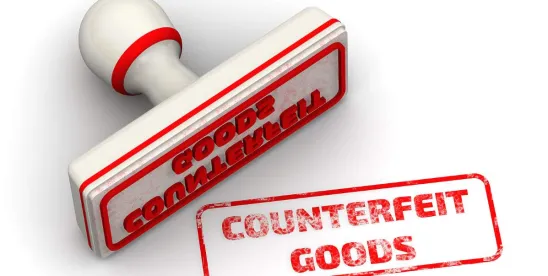In this two-part series, we show not only how to protect your brand from counterfeiting but also how your efforts to do so can simultaneously reduce organised crime, people trafficking, forced labour, toxic health risks and environmental crimes.
E-Commerce and Social Commerce: It is Big Business
Selling products via e-commerce and social commerce platforms is rapidly becoming a favoured path to market for businesses across the world. In 2025, retail e-commerce sales are estimated to exceed US$4.3 trillion worldwide,1 the equivalent of 3.7% of the total global economy. This figure is expected to grow in coming years. Whilst online marketplaces account for the largest share of online purchases worldwide, social commerce has become increasingly popular and in 2025, sales through social networks accounted for an estimated 17.11% of total online sales.2 According to a recent worldwide survey, more than half of consumers belonging to Generation Z bought something on social media platforms and nearly a third of overall consumers bought on social media platforms.3 The enormous volume of direct-to-consumer sales that now occur online, combined with the degree of anonymity and worldwide reach of online trade, makes it easier than ever for counterfeit products to be sold.
Hidden Theft: The Insidious Damage Caused by Counterfeits
The magnitude of international trade in counterfeit and pirated products was recently reported at a startling AU$464 billion, or 2.5% of world trade.4 On top of financial loss to businesses and economies, counterfeits cause loss of jobs and serious harm to people. One 2020 UK Intellectual Property Office study reported that counterfeiting caused job losses of 80,500 in the United Kingdom and 434,000 in the European Union each year.5 EU data from 2018–2021 showed the clothing industry lost 160,000 jobs6 with the cosmetics and toy sectors losing 32,0007 and 3,600 respectively.8 A recent Organisation for Economic Co-operation and Development (OECD) report found that trade in dangerous fakes represented a third of global trade in counterfeit goods.9 This includes children’s clothing which contain toxic materials and are made in a way that poses risks of choking and fire; cushions made from toxic dyes that can cause cancer and affect reproduction; and toys that contain chemicals that damage the liver, kidney, lungs and reproductive system.10 Even just one incident of a brand being associated with a counterfeit product which causes consumer harm can have long-term damage to the brand’s reputation, profit and workforce as well as devastating societal costs. The sale of counterfeits of a well-known toothpaste brand, which contained chemicals commonly found in solvents and antifreeze, made headline news around the world.11
Ultimately, the best outcome is to stop the counterfeiting at the source, and stakeholders, including the platforms, brand owners, governments and law enforcement officials, are moving towards collaborative models12 to share vital data, such as names, location, and volume of product, enabling legal action. Meanwhile, there are some critical steps that intellectual property (IP) owners can take to ensure they are best placed to combat online counterfeiting. These steps will also ensure the best chances to stop counterfeits at the source.
Register to Lock It: Do You Have Appropriate IP Protection?
Would you buy a new bike and not buy a lock? Ensuring that your product has appropriate IP protection is fundamental to fighting online counterfeiting. Products, brands, logos and designs are protected by IP registrations. These registrations are key in fighting against theft of your IP. In 2022, eBay removed over 2.7 million counterfeit items based on reports from rights owners and eBay community members.13 E-commerce and social platforms mostly will not act for rights owners against infringing products unless you can provide evidence of an IP registration. It is hard to ask others to care about your IP if you do not show that you care through registration protection.
Perform due diligence on what IP you have in your product or business and obtain appropriate registrations. This could be a trademark registration for your brand or logo, a design registration for the way your product looks, or a patent registration for your new inventive product.
Consider the online context and the way counterfeits of your product could be sold. Some platforms provide livestream shopping, where brands promote and sell products through livestream in real time, regularly using a celebrity or influencer (for example, Facebook Live Shopping). Counterfeit products are often shown on these livestreams, with no visual or verbal mention of the genuine brand name. Not only are these infringements hard to detect, but they may also not constitute trademark infringement of the brand. Savvy IP owners who also protect their product get-up or the shape of their product packaging through design or trademark registrations will be better placed to pursue infringers in this context.
As IP registrations are national rights, consider the countries where protection is required, which will typically be where you sell and manufacture your product. Leverage the IP systems in each country to your benefit. Some countries like the United States, China and Japan have a copyright registration system and being able to submit evidence of copyright registration to a platform when reporting an infringement can be valuable, particularly when misuse of your brand is not occurring but designs or images in which you own copyright are being used.
Engage with an IP professional early in your business or product life so you can collate, prioritise and register your IP and be ready to enforce your rights. Ultimately, some level of protection is better than none, and if you are at early stages of your business, you can scale up and broaden protection, balancing cost and need.
Choose Wisely: Use Verification and Authenticity Processes
Only sell through social or e-commerce platforms that have rigorous seller verification processes. Not only can this give customers comfort they are buying from the legitimate brand owner, but the platform will be collecting seller data which could be valuable in identifying bad actors selling counterfeits.
Amazon requires sellers to provide identity, address, bank and phone details which it then verifies, either through forgery detection, facial recognition, and liveness detection technology or via a video call with an Amazon representative.14 Verified sellers can also receive a “badge” verifying they are the manufacturer of a product. Sellers on eBay are required to verify identity, bank account details for payouts, and business details before payouts can be made.15 Sellers on Temu are required to verify their business and product, which includes providing a business licence, tax ID and applicable product and certifications.16
Informed consumers make better decisions and educating your customer base that your business and authorised sellers of your products only sell on platforms requiring seller verification may help reduce counterfeit sales.
Educate to Eradicate: How Can I Educate my Consumers and the Platforms?
Education and engagement with both consumers and e-commerce and social platforms about what constitutes genuine and counterfeit products are vital for combatting the insidious public and economic impact of counterfeit products.
Would you buy those fake high-fashion-brand sunglasses if you knew that they were the product of forced labour?17 Or purchase your favourite skin cream from a website selling 50% cheaper than usual if you knew it contained copper, mercury, arsenic and carcinogenic phthalate chemicals, which can cause skin reactions and poisoning and hormonal disruption?18
IP owners can educate their consumers by publishing information on their websites naming known counterfeits or explaining how to identify genuine and counterfeit products, including providing virtual tours of a genuine product lifecycle from manufacture to market. Chanel has a dedicated webpage describing the action it takes against counterfeiting.19 Lululemon has a section on their website, “How can I help prevent counterfeiting?”, encouraging its customers to educate and protect themselves against purchasing counterfeit products.20 The company went a step further in 2023, hosting a “Dupe Swap” at its Century City Mall location in Los Angeles, encouraging people who had lookalikes of their popular Align pants to trade them for the genuine article.21 This allowed them to engage with those consumers and demonstrate the superior quality of their brand.
You could also explain the health consequences (discussed above) of counterfeits or how counterfeits fund organised crime networks typically involved in illicit trade, including people trafficking, drugs, weapons, forced labour, environmental crimes, personal fraud, identity theft and money laundering.22
Similarly, platforms will only act against infringers if they have information about your brand and product. Providing as much information as possible to platforms and using the IP enforcement options available on these platforms to enforce these rights is essential. As stated by Ms. Maral Behnam-Garcia, the then senior director of Brand Protection & IP at Wish:
“[O]ne of the things that I think that brands don’t realise is there are hundreds of thousands of brands out there in the world, and we are not familiar with your brand. And so, in order for us to become familiar as a platform with your brand, we need partnership, we need collaboration, we need training, we need you to approach us as your partner rather than as the evil enemy of being an ecommerce marketplace platform.”23
All platforms require verified IP rights information before acting against IP-infringing listings. However, some also provide opportunities to give much more detailed information about a brand and its products. Participants in eBay’s Verified Rights Owner (VeRO) program can create a profile page which allows you to share information about your IP rights with the eBay community. The information you can provide includes a list of your intellectual property (including brands, trademarks and copyright), the potential consequences of infringing your business’ IP rights, the conditions under which products bearing your IP may be sold, and how to contact you directly with questions or concerns. The number of brands that participate in this program is substantial and ranges from well-known to lesser-known brands.24
Just as brands engage with customs officials to educate them about the brands and genuine products, so too should brands engage with and educate platforms to join forces in the fight against counterfeit sales.
Our next article in this series summarises enforcement and technological tools available to IP owners against online counterfeiting.
Footnotes:
1 Keon van Gelder, E-commerce worldwide – statistics & facts (Web Page, 4 March 2025), https://www.statista.com/topics/871/online-shopping/#topicOverview.
2 Statista Research Department, Social commerce as a percentage of total e-commerce worldwide from 2018 to 2029 (Web Page, 10 March 2025), https://www.statista.com/statistics/1251145/social-commerce-share-worldwide/.
3 L. Yltävä, Statista, Share of consumers buying products on social media in 2024, by generation (Web Page, 14 March 2025), https://www.statista.com/statistics/1273928/share-social-buyers-age-group-worldwide/.
4 OECD and European Union Intellectual Property Office (EUIPO), Global Trade in Fakes: A Worrying Threat (Report, 22 June 2021), page 52, Global Trade in Fakes | OECD, page , euipo.europa.eu/tunnel-web/secure/webdav/guest/document_library/observatory/documents/reports/2021_EUIPO_OECD_Report_Fakes/2021_EUIPO_OECD_Trate_Fakes_Study_FullR_en.pdf
5 Intellectual Property Office, IPO Counterfeit Goods Research (Report, July 2020), page 30, IPO Counterfeit goods research – February 2020
6 EUIPO, Economic impact of counterfeiting in the clothing, cosmetics, and toy sectors in the EU (Report, 2024), page 28, euipo.europa.eu/tunnel-web/secure/webdav/guest/document_library/observatory/documents/reports/2024_Clothing_Cosmetics_Toys/2024_Economic_Impact_of_counterfeiting_in_clothing_cosmetics_toys_FullR_en.pdf
7 Ibid, page 7.
8 Ibid, page 7.
9 OECD and EUIPO, Dangerous Fakes: Trade in Counterfeit Goods That Pose Health, Safety and Environmental Risks (Report, 2022), page 52, euipo.europa.eu/tunnel-web/secure/webdav/guest/document_library/observatory/documents/reports/dangerous-fakes-study/dangerous-fakes_study_en.pdf
10 Ibid, page 21.
11 Ibid, page 27.
12 Amazon, The latest from Amazon’s Counterfeit Crimes Unit: Efforts with Cisco lead to the dismantling of counterfeit rings (Web Page, 2 December 2024), https://brandservices.amazon.com/counterfeitcrimesunit.
Amazon’s Counterfeit Crimes Unit (CCU) described itself as partnering with “brands and law enforcement to stop bad actors, as well as work upstream from the counterfeit signals the team detects to identify, seize, and appropriately dispose of counterfeit products, resulting in Amazon removing more than 7 million counterfeit products worldwide in 2023 alone. Since the CCU’s founding, the team has pursued more than 21,000 bad actors through litigation and criminal referrals to law enforcement”.
13 eBay, eBay Global Transparency Report (Report, 2023), page 3.
14 Amazon, Seller Verification Guide (Guide, undated), https://sell.amazon.com.au/sell#read-the-seller-verification-guide.
15 eBay, Registering as a seller (Web Page, undated), https://www.ebay.com.au/help/selling/getting-paid/registering-seller?id=4792.
16 New sellers can register via the parent company website, Pinduoduo, available at https://ims.pinduoduo.com/overSea?from=domestic or via email to Temu, seller@temu.com, which initiate a similar verification process.
17 Phil Lewis, Global collaboration vital in the fight against counterfeiting(Anti-counterfeiting and Online Brand Enforcement: Global Guide, 2024), page 5.
18 Ibid.
19 See: https://www.chanel.com/au/anti-counterfeit/
20 Lululemon, Resale + Brand Protection (Web Page, undated), https://shop.lululemon.com/about/our-product/resale-brand-protection.
21 Matthew Stern, Forbes Magazine, Lululemon has a bold strategy for dealing with dupes (Web Page, 25 May 2023), https://www.forbes.com/sites/retailwire/2023/05/25/lululemon-has-a-bold-strategy-for-dealing-with-dupes/.
22 Phil Lewis, Global collaboration vital in the fight against counterfeiting(Anti-counterfeiting and Online Brand Enforcement: Global Guide, 2024), page 5.
23 ‘M. Behnam-Garcia, Director of Brand Protection & IP at Wish’, Heroes of Brand Protection (Red Points, 9 September 2021) at 11:37 mins.
24 See the list of participating brands here: https://www.ebay.com/sellercenter/ebay-for-business/verified-rights-owner-program#appendix-T.





 />i
/>i

